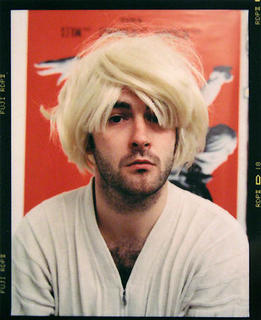
"The Vanity of Allegory," is a show organized by conceptual artist Douglas Gordon at the Deutsche Guggenheim, located in the Deutsche Bank building on Unter der Linden. Billed as "a self-portrait in the guise of a group exhibition," the event brings together more than 30 works by artists who have previously shown at the museum, including Matthew Barney, Cerith Wyn Evans, Damien Hirst, Roni Horn, Jeff Koons, Robert Mapplethorpe and Lawrence Weiner. But if this is an exploration of the self-portrait, vanity and the search for immortality, Gordon becomes sort of a "man with a thousand faces" by highlighting relationships between apparent opposites. Here is Gordon’s own photographic portrait in masquerade as Kurt Cobain. He also mocked Andy Warhol, Myra Hindley and Marilyn Monroe (not shown).
___________________________________________________________
On a different note, I'll post some interesting links this weekend. Also updated the syllabus with confirmed visitors. Over...
7 comments:
i'm not quite clear on the concept of the exhibition.
"a self portraint in the guise of a group exhibition"
whose self portrait? douglas gordon's?
so it would be gordon's self portrait using other artists?
what of the mocks of the celebrities?
i don't understand.
although, i'd love to see what matthew barney is doing for this exhibition.
He organized the show of a bunch of other artists (including himself). It's not the role of a curator properly, but bringing people and letting them do what they want. Each artist addressed some kind of self-portraiture (in a broad sense) around the vanity of allegory. I'd love to see this show.
i just realized that kurt cobain and andy warhol had very similar hair-dos.
on a side note, how does marilyn monroe look with a five o'clock shadow?
Glass is about a department store window in size. Duchamp mixes some isolated components, such as the chocolate grinder and the glider, shown with painstakingly convincing perspective. In a 1913 note, Duchamp writes: “No obstinacy, ad absurdum, of hiding the coition through a glass pane with one or many objects of the shop window. The penalty consists in cutting the pane and in feeling regret as soon as possession is consummated, Q.E.D.” Some people call Glass a love machine, some call it a machine of suffering. In her essay on Bride, Janis Mink writes: “Its upper and lower realms are separated from each other forever by a horizon designated as the bride's clothes. The bride is hanging, perhaps from a rope, in an isolated cage, or crucified. The bachelors remain below, left only with the possibility of churning, agonized masturbation.” I don’t like to read too much into them, other than it contains many Duchampian elements. Through the years, D. kept sort of appropriating himself over and over to recreate his work. Duchamp once told Lawrence Steefel that “I want to grasp things with the mind the way the penis is grasped by the vagina.”
i can relate to the whole self portrait-mortality issue. in high school when i was in my portfolio class, i became fascinated with doing self portraits because for some reason i could never truly capture myself. i'm actually still trying to reach that goal. i'm sure i'll find it someday.
Man of a thousand faces... I like it. No so much that he wants to make himself immortal threw the use of photograph but more the idea that we all are searching for who we are and we have to try out different things before we find who we are or that in different situations we take on different personalities.
I love self portraits because it is a way to express the most deeply feelings towards life. A photograph tells more than a thousand words. Pictures are so meaningful because they allow memories to feel more realistic and actually persuade our minds to remind us of a specific event inour lives. They have the power to bring back memories, feelings of forgotte times, and even take us on a journey through experiences once lived
Post a Comment